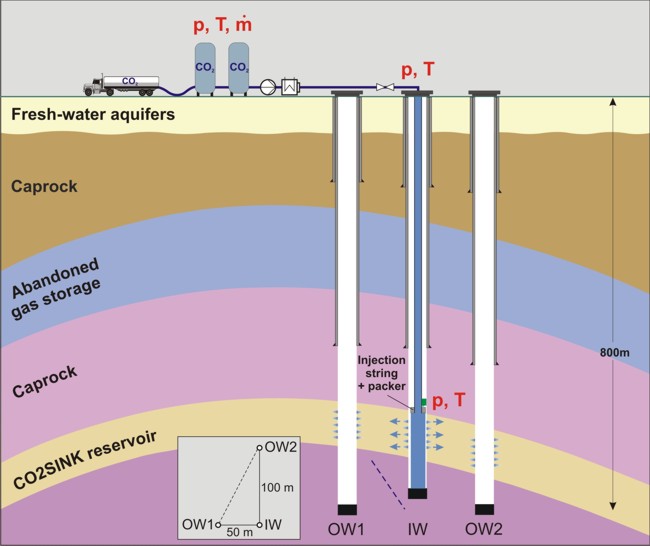|
Injection

Injection string
| case |
size |
wt |
length |
wall |
grade |
connections |
internal coating |
|
mm
(in)
|
kg(m
(lb/ft)
|
m
(ft)
|
mm
(in)
|
|
|
|
|
slimhole |
73
(2.875)
|
9.52
(6.4)
|
680
(2231)
|
5.5
(0.217)
|
L80* |
IF / Premium |
yes
(e.g. TK-236)
|
Table 1: Injection string specifications
Downhole pressure gauge above permanent production packer in ~700 m depth; optical fibre service line fed back to surface on injection string (attached via metal cable); the cable specifications are:
- Optical cable encased in 1/4" 0.028" wall Incoloy 825 tube
- Encapsulated to 11mm x 11 mm square in polypropylene for full 100 Deg C compatibility
The CO2 will be delivered in liquid state to Ketzin by trucks. It has to be conditioned (i.e. heated and gasified) prior to injection. The thermodynamic aspects of this process have been analysed. A numerical simulation model has been developed to identify lower and upper boundaries for the injection inlet temperature of the CO2 at a given injection rate and pressure. The CO2-conditioning facility will be designed according to the delineated upper pressure and temperature conditions:
-
continuous injection of 1 kg/s gaseous CO2
-
well head conditions: p = 66-74 bar, T = 24-45°C (CO2 (99.99 Vol%), EIGA)
-
bottomhole conditions: p = 75-85 bar, T = 50-60°C
Fig. 1: Simulated bottomhole pressure as function of bottomhole temperatures (left) and of well head temperatures (right). Graphs are parametric in the wellhead pressures between 6..9 MPa (Kastner et al., 2005, submitted).
As the heating of the CO2 during injection operation is an energy-demanding process, this process has to be designed and performed as economic as possible. To ensure an ideal operation regime, surface and downhole pressure-temperature sensors will be installed. Thereby it will be possible to iterate the process and find the optimum conditions.
Reference:
Kastner, O., Legarth, B., 2005: CO2 Storage In Ketzin: Thermodynamic and processing aspects of the CO2 injection into geological formations, Energy, submitted.
|
